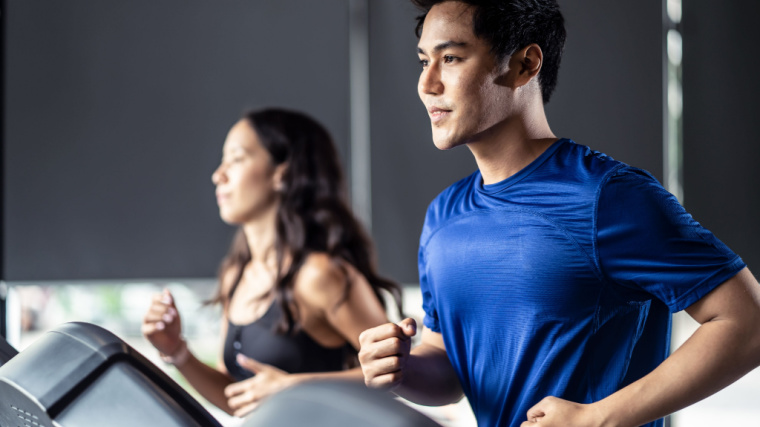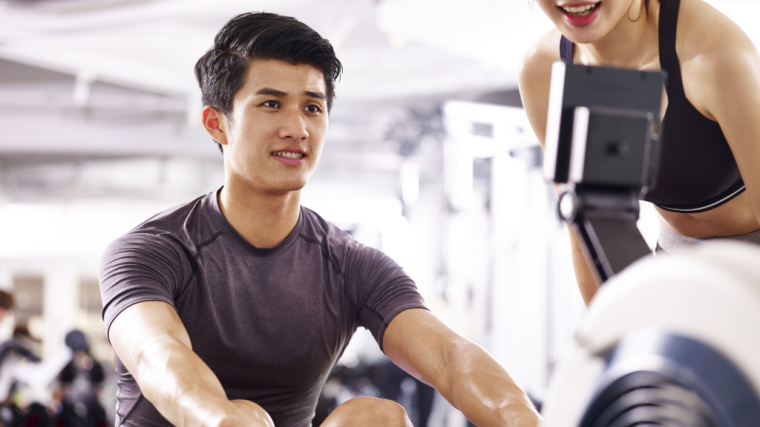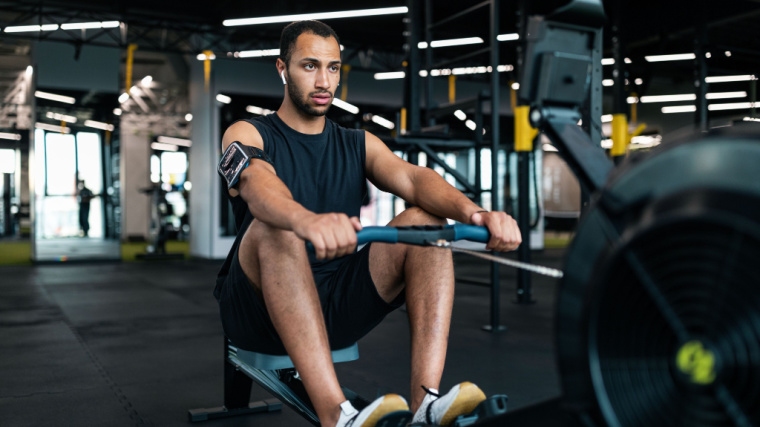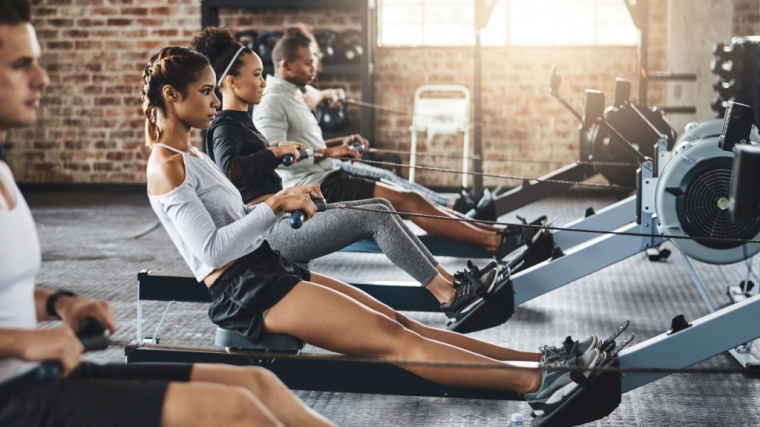It’s time to get your cardio game face on. Whether you want to get your blood pumping for an active recovery day or are trying to create a cardio routine to supplement your strength training, you’ve got to choose your mode of exercise wisely.

Given the choice, many lifters will be confronted with the question of treadmill versus rowing machine. Both machines are widely available at commercial gyms — but they offer different benefits. Which one you choose will depend on your goals and preferences. Read on to find out whether the rower or running is better for you.
Is Running or Rowing Better for:
Editor’s Note: The content on BarBend is meant to be informative in nature, but it should not be taken as medical advice. When starting a new training regimen and/or diet, it is always a good idea to consult with a trusted medical professional. We are not a medical resource. The opinions and articles on this site are not intended for use as diagnosis, prevention, and/or treatment of health problems. They are not substitutes for consulting a qualified medical professional.
Running Vs. Rowing
It’s no secret — even if it’s not a well-liked notion — that strength athletes need at least a bit of cardio to keep their program strong. If you want to keep getting stronger, recover better, and have the kind of work capacity you need to fuel those intense workouts, you’ll need at least some cardio.
But should you pound the pavement or integrate some rowing workouts into your program? Rowing is low-impact — no banging of your joints in sight. You’ll be using your arms and back very actively when you row, whereas your arms and torso are much less directly involved when you run.
Running, on the other hand, requires no equipment. Sure, treadmills are nice, but you don’t need them. As long as you have a safe outdoor space, you can go for a run whenever and wherever you want. Running gets your heart pumping in a way that rowing typically does not, meaning that you might be able to get more of that sweet cardio vibe while jogging.
Is Running or Rowing Better for Muscle-Building?
Contrary to popular belief, running doesn’t eat away at your muscles. While the interference effect — where one training goal interferes with another and cancels out your gains — might impact your program, increasing your muscular endurance through running can actually help you get stronger over the long term. (1)(2)(3)
Especially if you go for your runs after your lifting sessions (instead of before), going for 15 to 45-minute runs just isn’t going to atrophy your muscles. Make sure you’re eating as many calories as you need to maintain muscle along with the added calorie burn of running, and you’ll be alright. (1)(2)(3)
That said, studies have shown that you recruit more muscle mass during rowing workouts than you do while you’re running. (5) And since running tends to burn more calories than rowing, the latter might be more helpful if you’re focusing on growth. (5) So if you’re looking to get bigger, rowing might be better than running for hypertrophy.
Is Running or Rowing Better for Strength?
Since you’ll be using so much muscle mass across your entire body during rowing, it makes sense to assume that rowing is better than running for strength. Sure enough, research suggests that combined with heavy strength training, rowing can help you improve max strength and power. (4)
But don’t count running out if your goal is to get stronger. Remember, well-programed running is not the enemy of your muscles. (1)(2)(3) The muscular endurance and increased work capacity that you can build while running can help make you stronger in the long run (pun intended).
The better you can recover between strength sets and the better you can tolerate medium-to-high rep sets, the better foundation you can build for max strength. In that way, running can definitely help get you stronger.
Still, if you’re looking for a more straightforward way to help boost your strength, rowing might take the proverbial cake here.
Is Running or Rowing Better for Cardio?
Research suggests your VO2 max is likely to be higher while rowing than it is during a bout of running. (7) Your VO2 max indicates the maximum amount of oxygen your body can process while you’re exercising — the higher you can train this to be, the more efficiently you’ll be able to work out. It’s therefore a solid indicator of cardiovascular capacity and health.
That said, rowing doesn’t necessarily jack up your heart rate the same way that running might. (7)(8) This means that you might be able to process oxygen more efficiently while experiencing less of an increase in your heart rate.
Rowing therefore might be more comfortable for athletes who may get nervous when their heart beats a lot faster than normal. But that comfort doesn’t take away from greatly improved cardiovascular health, since your VO2 max is likely to be higher while rowing.
However, if you’re trying to train in a specific heart rate zone — i.e., trying to get your heart rate up during training to better acclimate your cardiovascular system to intense exercise — running might be a better option. (8)
Training with the same RPE (rate of perceived exertion) while running may give you a greater physiological response than rowing. (8) Because of this, running might be more suitable for heart rate-focused cardio training.
But not all cardio is created equal for all athletes. If you have a history of injuries, adaptive rowers have been shown to help improve athletes’ VO2 max and overall strength. (9)(10) So if you prefer or need a low-impact cardio option, rowing is likely going to be your winner.
Is Running or Rowing Better for Fat Loss?
All things being equal, research suggests that running on a treadmill oxidizes fat more efficiently than rowing. (6) Of course, if you’re looking to lose body fat, you’ve got to match your calorie intake to your goals. At first blush, running may make this easier than rowing.
However, rowing involves very active recruitment of muscle mass throughout your body. (4) Combined with the low-impact nature of rowing, this may make high-intensity interval training (HIIT) workouts more accessible on the rower than a sprint workout.
Many lifters are more likely to turn to HIIT when their goal is fat loss, and rowers might be a way to do this that’s easier on your body. Sprint workouts are an effective form of HIIT, but may take a greater toll on your body because it’s higher impact. So rowing might win out if your goal is to pursue fat loss via HIIT.
Is Running or Rowing Better for Active Recovery?
Active recovery is all about concentric muscle contractions that aren’t going to tax you too much. That’s why sled pushes and kettlebell swings are such great options for active recovery.
Both of those exercises have a lot in common with rowing — first and foremost, they’re low-impact cardio options, which are great for active recovery. So if you’re looking for something that’s low-impact with an emphasis on concentric movement, rowing is going to be better for active recovery.
That said, you might prefer to stay out of the gym entirely during your active recovery days. Being around all those dumbbells and barbells might just be too tempting, and you may find yourself lifting heavy weights when you’re not supposed to. If you’d prefer to keep yourself outside the gym during active recovery days, running may be the superior choice.
This is also true for athletes who are very experienced with running. If you’re a strength athlete but are very comfortable with running — and your feet and knees don’t tend to object to the higher impact — there’s no reason you can’t incorporate slow running or jogging into your active recovery routine.
Is Running or Rowing Better for Strength Athletes?
Let’s keep one thing at the top of mind — running is not the enemy of strength athletes. If you have plantar fasciitis or another potentially running-related repetitive stress injury, hitting the treadmill is likely not the best option for you. But all things being equal, running and rowing are both viable candidates.
But athletes are always looking for the best option for their goals. The way your goals take shape depends largely on your experience level and sport. For example, a beginner might want to build strength, but a beginner’s training program is still going to look a lot different than a powerlifter or weightlifter also looking to increase strength.
Here’s your guide to figuring out whether you should run or row, depending on both your goals and your sport.
Beginners
If you’re a beginner, you’re likely to be basking in those newbie gains. But if you’re a fresh new face in the gym, one of your biggest struggles might be making your training program a habit. In this case, sticking with your program is likely to be your biggest goal for a while.
With that in mind, beginners might what to choose whichever option they like best. If you force yourself to run when you hate it or tell yourself you have to row when it makes you miserable, you’re cooking up a recipe for calling it quits before you see those gains.
Choose what’s sustainable for you and start there — research suggests that forming a solid habit based on what you enjoy is going to help you get closer to those goals. (11)
Recreational Gymgoers
For your average weekend warrior or non-competitive lifter, you’ll want to take into account a combination of what you enjoy and your training goals. Even if rowing might have an edge over running in terms of building muscle, it won’t do you too much good if you hate rowing.
Recreational lifters looking to get more cardio into their program might choose to integrate slow jogging and easy rowing into both their warm-up and cool-down routines. Three to five minutes of rowing before your workout and three to five minutes of jogging after your session can help you strike a balance between these modalities.
CrossFitters
CrossFitters need to run and train on the rower. There are no two ways around it — you’ll need both in various WODs (workouts of the day) and potential competitions. Unless you’re aiming to accomplish a particular speed during your runs, you can generally stick with slow or moderately-paced five or 10k runs as a CrossFitter. Sprinkle in sprints as needed.
For a casual CrossFitter, the rower might help with building mental fortitude during intense HIIT-style WODs. Since you’ll be using so many muscles, you’ll really feel that burn during high-intensity rowing sessions. Developing the ability to push through this burn and keep going is a great skill for a CrossFitter.
Weightlifters
Weightlifters need a healthy dose of conditioning to fuel their long, intense training sessions. Since rowing features a lot of pulling, this extra volume might be helpful for weightlifters. You’ll also be using your quads and glutes to push off at the beginning of each stroke — another benefit of rowing for weightlifters.
If you’re a weightlifter who likes running, consider incorporating some slow jogs into your cool-downs or active recovery days.
Make sure you’re prioritizing your lifts in your exercise order. Exhausting your physical and mental resources by running or rowing before your training sessions might take away the focus and precision you need to accomplish complex weighlifting moves.
Powerlifters
Powerlifters are always looking to build max strength. Since rowing is known to help increase max strength when combined with heavy strength training, the rowing machine is an obvious choice for powerlifters. (4)
That said, you want to develop you a better base for inter-set recovery as a powerlifter. Running might be a good choice for this because running trains your heart rate at a higher intensity than rowing. (7)(5)(8) This can bode well for jacking up your heart rate faster and more frequently.
Bodybuilders
The name of the bodybuilding game is muscle growth. While running is not antithetical to muscle growth, it might be helpful for bodybuilders to incorporate rowing so that they can involve as much muscle mass as possible.
But if you’re looking to aid your recovery, make sure you’re rowing at a low intensity so you’re not interfering with your muscles getting the time and space they need to heal from tough sessions. If low-intensity rowing isn’t your jam, a slow jog after a training session can kickstart your recovery as a bodybuilder.
Strongwomen and Strongmen
Strongman athletes might not have the body types to best support running. Since running is tough on your joints — particularly your knees and ankles — strongwomen and strongmen might opt for rowing instead.
Make sure you are getting enough conditioning under your lifting belt, though. Strongwomen and strongmen need to be well-conditioned to support various medleys, yoke walks, and intensive max press events. Integrating rowing intervals and longer, low-intensity rowing sessions can be a big boon for a strongman athlete’s program.
To Run or to Row?
Running or rowing are both fantastic ways to supplement strength training programs all across the spectrum of fitness goals. But your goals, along with your experience levels, injury history, and strength sport, will determine whether the rower or runner is best for you.
At the end of the day, the rower might win out when you’re looking to build muscle mass or get in some active recovery. Looking to focus on your cardiovascular endurance and heart health? You might want to try running instead. But whatever your goals, remember that both options are likely to help you out. Choose what you like and go from there.
References
- Wilson JM, Marin PJ, Rhea MR, Wilson SM, Loenneke JP, Anderson JC. Concurrent training: a meta-analysis examining interference of aerobic and resistance exercises. J Strength Cond Res. 2012 Aug;26(8):2293-307.
- Esteve-Lanao J, Rhea MR, Fleck SJ, Lucia A. Running-specific, periodized strength training attenuates loss of stride length during intense endurance running. J Strength Cond Res. 2008 Jul;22(4):1176-83.
- Luckin-Baldwin KM, Badenhorst CE, Cripps AJ, Landers GJ, Merrells RJ, Bulsara MK, Hoyne GF. Strength Training Improves Exercise Economy in Triathletes During a Simulated Triathlon. Int J Sports Physiol Perform. 2021 May 1;16(5):663-673.
- Thiele, D., Prieske, O., Lesinski, M., & Granacher, U. (2020). Effects of equal volume heavy-resistance strength training versus strength endurance training on physical fitness and sport-specific performance in young elite female rowers. Frontiers in Physiology, 11, 888.
- Yoshiga CC, Higuchi M. Heart rate is lower during ergometer rowing than during treadmill running. Eur J Appl Physiol. 2002 Jun;87(2):97-100.
- Filipovic M, Munten S, Herzig KH, Gagnon DD. Maximal Fat Oxidation: Comparison between Treadmill, Elliptical and Rowing Exercises. J Sports Sci Med. 2021 Mar 1;20(1):170-178.
- Yoshiga CC, Higuchi M. Oxygen uptake and ventilation during rowing and running in females and males. Scand J Med Sci Sports. 2003 Dec;13(6):359-63.
- Edwards AM, Lander PJ. Physiological responses to self-paced exercise: effort-matched comparisons across running and rowing modalities. J Sports Med Phys Fitness. 2012 Aug;52(4):344-50.
- Sawatzky B, Herrington B, Choi K, Ben Mortenson W, Borisoff J, Sparrey C, Laskin JJ. Acute physiological comparison of sub-maximal exercise on a novel adapted rowing machine and arm crank ergometry in people with a spinal cord injury. Spinal Cord. 2022 Aug;60(8):694-700.
- Jeong, J. R., Lee, B. S., & Park, D. S. (2014). Kinematic analysis of rowing exercise using a motor-assisted rowing machine for rowers with spinal cord injury: a case report. Physical Therapy Rehabilitation Science, 3(1), 69-75.
- Judah G, Gardner B, Kenward MG, DeStavola B, Aunger R. Exploratory study of the impact of perceived reward on habit formation. BMC Psychol. 2018 Dec 20;6(1):62.
Featured Image: StratfordProductions + Samuel Borges Photography


